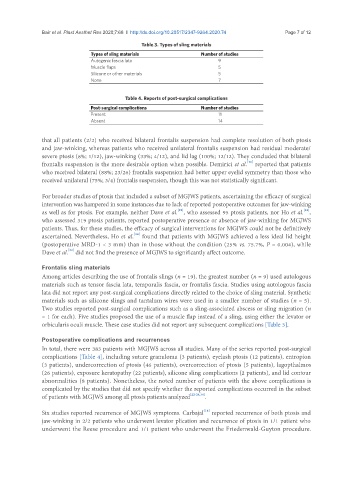Page 803 - Read Online
P. 803
Bair et al. Plast Aesthet Res 2020;7:68 I http://dx.doi.org/10.20517/2347-9264.2020.74 Page 7 of 12
Table 3. Types of sling materials
Types of sling materials Number of studies
Autogenic fascia lata 9
Muscle flaps 5
Silicone or other materials 5
None 7
Table 4. Reports of post-surgical complications
Post-surgical complications Number of studies
Present 11
Absent 14
that all patients (2/2) who received bilateral frontalis suspension had complete resolution of both ptosis
and jaw-winking, whereas patients who received unilateral frontalis suspension had residual moderate/
severe ptosis (8%; 1/12), jaw-winking (33%; 4/12), and lid lag (100%; 12/12). They concluded that bilateral
[16]
frontalis suspension is the more desirable option when possible. Demirici et al. reported that patients
who received bilateral (88%; 23/26) frontalis suspension had better upper eyelid symmetry than those who
received unilateral (75%; 3/4) frontalis suspension, though this was not statistically significant.
For broader studies of ptosis that included a subset of MGJWS patients, ascertaining the efficacy of surgical
intervention was hampered in some instances due to lack of reported postoperative outcomes for jaw-winking
[24]
[22]
as well as for ptosis. For example, neither Dave et al. , who assessed 95 ptosis patients, nor Ho et al. ,
who assessed 319 ptosis patients, reported postoperative presence or absence of jaw-winking for MGJWS
patients. Thus, for these studies, the efficacy of surgical interventions for MGJWS could not be definitively
ascertained. Nevertheless, Ho et al. found that patients with MGJWS achieved a less ideal lid height
[24]
(postoperative MRD-1 < 3 mm) than in those without the condition (25% vs. 75.7%, P = 0.004), while
Dave et al. did not find the presence of MGJWS to significantly affect outcome.
[22]
Frontalis sling materials
Among articles describing the use of frontalis slings (n = 19), the greatest number (n = 9) used autologous
materials such as tensor fascia lata, temporalis fascia, or frontalis fascia. Studies using autologous fascia
lata did not report any post-surgical complications directly related to the choice of sling material. Synthetic
materials such as silicone slings and tantalum wires were used in a smaller number of studies (n = 5).
Two studies reported post-surgical complications such as a sling-associated abscess or sling migration (n
= 1 for each). Five studies proposed the use of a muscle flap instead of a sling, using either the levator or
orbicularis oculi muscle. These case studies did not report any subsequent complications [Table 3].
Postoperative complications and recurrences
In total, there were 383 patients with MGJWS across all studies. Many of the series reported post-surgical
complications [Table 4], including suture granuloma (3 patients), eyelash ptosis (12 patients), entropion
(3 patients), undercorrection of ptosis (46 patients), overcorrection of ptosis (5 patients), lagopthalmos
(26 patients), exposure keratopathy (22 patients), silicone sling complications (2 patients), and lid contour
abnormalities (8 patients). Nonetheless, the noted number of patients with the above complications is
complicated by the studies that did not specify whether the reported complications occurred in the subset
of patients with MGJWS among all ptosis patients analyzed [22-24,34] .
[18]
Six studies reported recurrence of MGJWS symptoms. Carbajal reported recurrence of both ptosis and
jaw-winking in 2/2 patients who underwent levator plication and recurrence of ptosis in 1/1 patient who
underwent the Reese procedure and 1/1 patient who underwent the Friedenwald-Guyton procedure.

